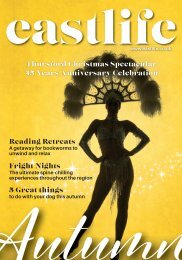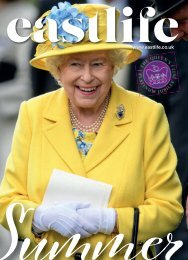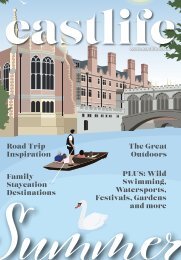Eastlife Spring 2020
With spring flowers, warmer weather and Easter on the horizon, we’re helping you get out of the winter slumber and embrace the great outdoors. Spend the afternoon exploring the sleepy villages of Norfolk or Suffolk, learn to sail on the Broads or punt along the River Cam. Find out more about beach hut hire on the pretty shores of Mersea Island or discover the likes of Ely, Colchester and Ipswich with our travel guides.
With spring flowers, warmer weather and Easter on the horizon, we’re helping you get out of the winter slumber and embrace the great outdoors. Spend the afternoon exploring the sleepy villages of Norfolk or Suffolk, learn to sail on the Broads or punt along the River Cam. Find out more about beach hut hire on the pretty shores of Mersea Island or discover the likes of Ely, Colchester and Ipswich with our travel guides.
You also want an ePaper? Increase the reach of your titles
YUMPU automatically turns print PDFs into web optimized ePapers that Google loves.
Suffolk
A Bury
long time…
A year-long events programme marks
1000th anniversary of Abbey of St Edmund
Bury St Edmunds in Suffolk will be celebrating the
1000th anniversary of the founding of the Abbey of St
Edmund by King Canutem, with a programme of events
throughout 2020 leading up to the weekend of St
Edmund’s Day on 20 November.
The first Patron Saint of England, Edmund was crowned
King of East Anglia at Bures in Essex on Christmas Day
855. He was canonised as a saint in 890.
A great battle took place when the King’s Army faced
The Danes at Thetford in Norfolk; Edmund fled but was
‘found’ by the Danes. Refusing to give up his Christian
faith, he was tied to a tree and shot full of arrows before
being beheaded on 20 November 869, now marked as
St Edmunds Day. The Danes believed that once a head
was severed a person would not go onto a higher plain.
Credit: Rebecca Austin
The King’s followers discovered his body but no head.
They heard a cry of ‘hic, hic, hic’ from a thicket (Latin
for here, here, here) and they investigated to find a wolf
guarding the head. The head was put to the body and
the first miracle of the future saint occurred when body
and head fused.
St Edmund was enshrined in the Abbey bringing visits
from across the UK and abroad including Royalty as it
became one of the most famous and wealthy pilgrimage
locations in England. The Abbey was destroyed during
the dissolution of the monasteries in 1539. Edmund’s
bejeweled shrine was plundered but his body was
missing and his whereabouts are still a great mystery to
this day. A theory is that his remains were placed in an
iron chest and may be buried in the monks’ cemetery,
which lies beneath the tennis courts in the Abbey
Gardens, which is consecrated ground.
Today, the extensive Abbey remains include the
complete 14th century Great Gate and Norman Tower,
as well as the impressive ruins and altered west front of
164
Credit: Tom Soper
















